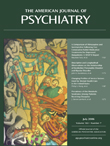Since George Engel’s seminal paper in 1977, “biopsychosocial” has become a shibboleth for psychiatry
(1) . Rarely in my experience does a book so thoroughly examine the interaction of psychosocial and biological factors that may cause a disorder. In the preface, the authors pose the question, “Can stress cause depression?” The book is “structured around three major themes: the pathophysiological role of stress in depression; the question whether a subtype of depression exists, being particularly stress-inducible; and finally, the dilemma of diagnosing depression in a way to meet best the requirements of research and its biological underpinnings.” Nine chapters pursuing these topics follow.
Chapter 1 is a critique of modern diagnostic schemes, in which the authors assert that “psychiatric diagnosing is locked up in a nosological strait jacket.” The authors elaborate that diagnosis in current DSM has given way to mere listing of symptoms. It is implied that just as the research diagnostic criteria were necessary for epidemiological consistency, now research requires a new diagnostic format characterized by what is later referred to as “functionalization” and “verticalization.” Functionalization consists of the establishment of a categorical diagnosis, a definition of predominant syndrome, an analysis of the symptoms of the syndrome, and the determination of the psychic dysfunction. Verticalization consists of prioritizing the psychopathological symptoms/psychic dysfunctions toward their relationship with the underlying neurobiological substratum.
Chapters 2, 3, and 4 cover traumatic life events and the role of these events in depression. The stress syndrome is discussed, and works by W.B. Cannon, Hans Selye, and Adolph Meyer are reviewed. Life-event research, decrying the frequent exclusion of how specific personalities cope with stress, is also discussed.
In Chapters 5 and 6, the genetics of depression and gene-environment interaction are covered. The authors raise the question “To what degree depression is the result of the interplay of genes and environment rather than the effects of either factor alone?” They conclude that although the research is sparse, interaction and correlations of genes and environment are shown to be common and of large effect.
Chapter 7 is an outstanding review of the biological determinants of depression, namely the monoamines. In chapter 8, the authors discuss the relationship of stress hormones and depression, concluding that stress hormone abnormalities are not typical for depression but occur only in a subgroup of depression. There is a very useful section on posttraumatic stress disorder, which is a disorder that is seen by many of us in increasing numbers. These sections may be heavy going for some readers because they cover both animal and human research, but they are worthwhile.
The last chapter, Chapter 9, describes the psychopathological and biological overlap between stress and depression. The authors state that “tentative evidence exists that depression might indeed be stressor-precipitated and anxiety/aggression driven.” This is connected to the concurrent presence of neurotic traits that thwart successful coping.
Finally, the book ends with an epilogue that recapitulates all of the chapters and answers the question in the preface by asserting that stress may induce depression but only in a subtype referred to as “anxiety/aggression driven depression”— more fully, “stressor precipitated, cortisol induced, serotonin-related anxiety/aggression driven depression.”
What a book! To what should it be compared? It doesn"t actually read like a novel, but it held my interest in much the same way a well-written novel would. I was continually tempted to look ahead to see where the authors were going. The book builds a sense of fascination from chapter to chapter.
This book is very well written and referenced. There are summaries after each section and concise conclusions at the end of each chapter. There are poetic phrases such as “neuroendocrine finger print” and “cascade of stress,” to name two. So much is covered: neuroanatomy, neuroendocrinology, neurotransmission, genetics, personality, and nosology.
I own and have practiced with all DSMs, from DSM-I to DSM-IV-TR. Admittedly, use of DSMs from DSM-III onward usually lead to interrater reliability, but the “shopping list” mentality and the criteria load do not lead to much differentiation. The book"s critique of current diagnostic nomenclature gives a cautionary note for work on future DSMs: Is a paradigm shift necessary?

